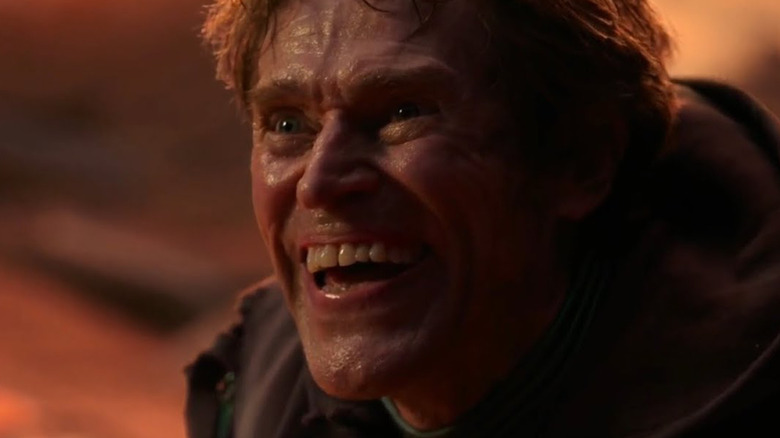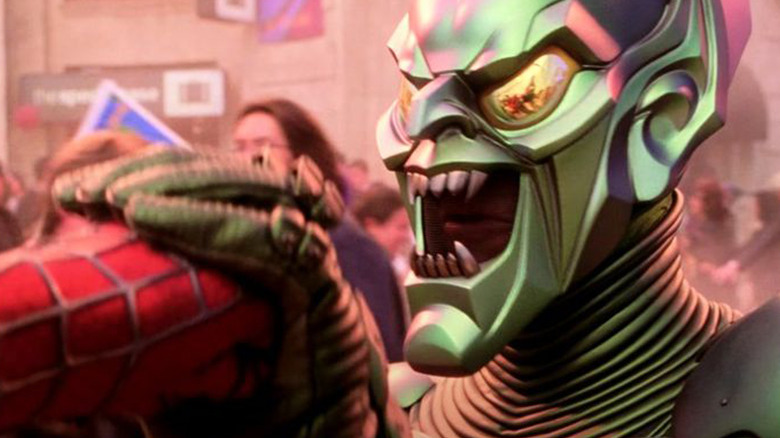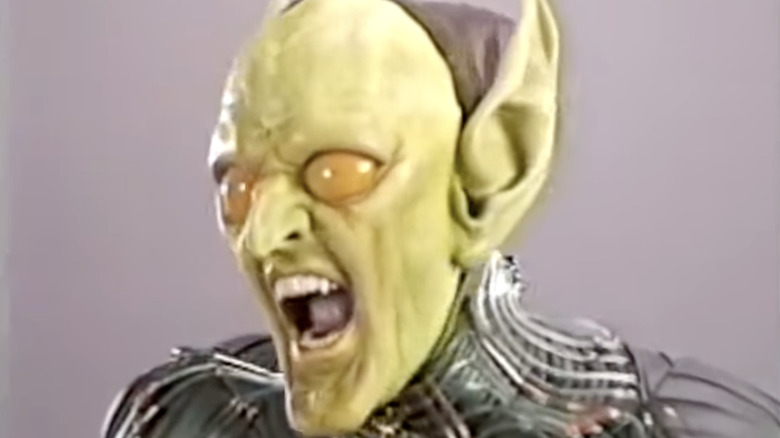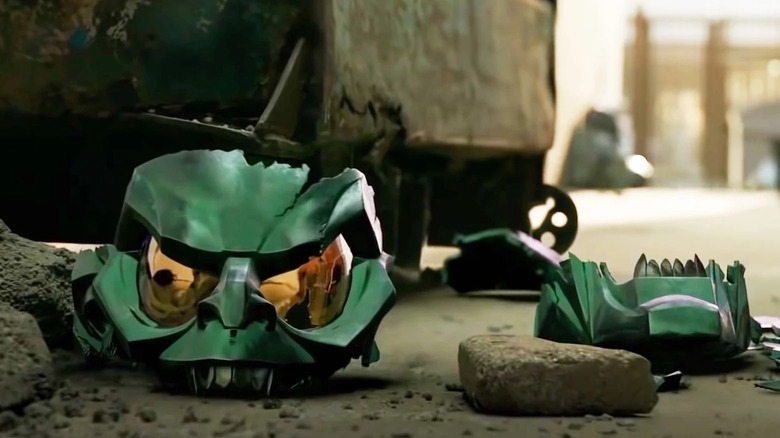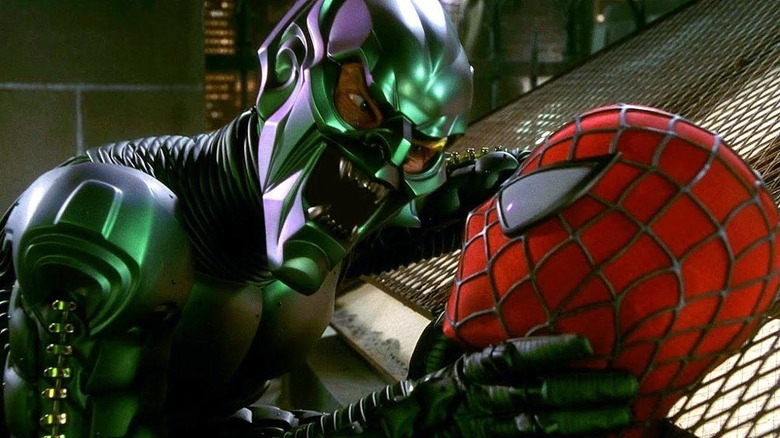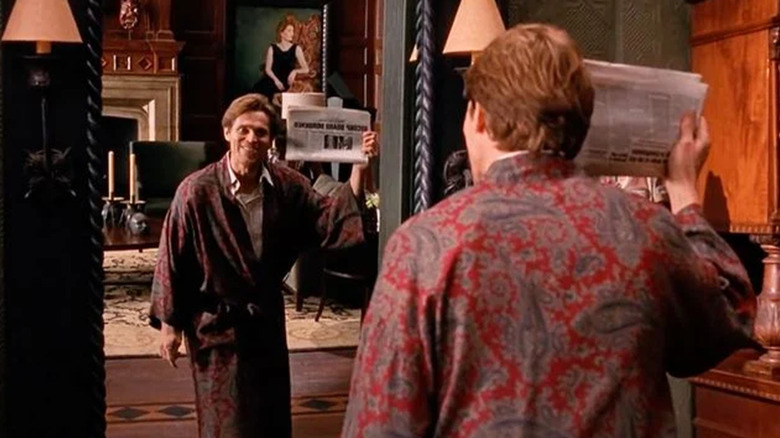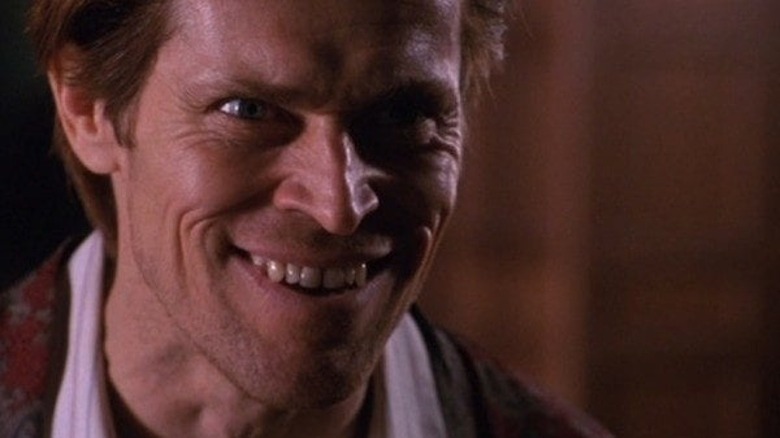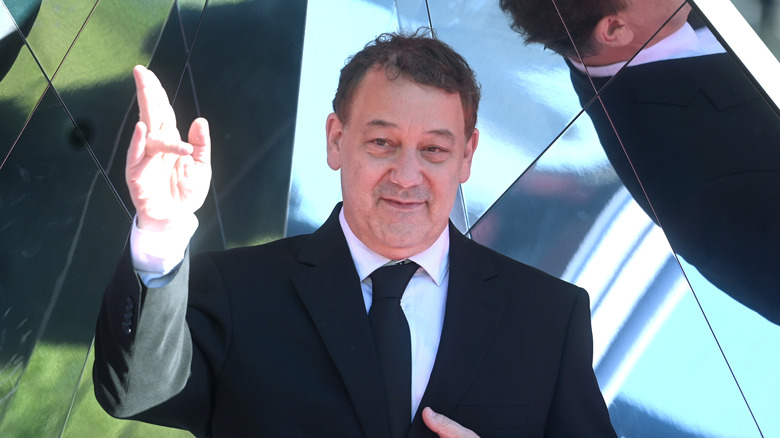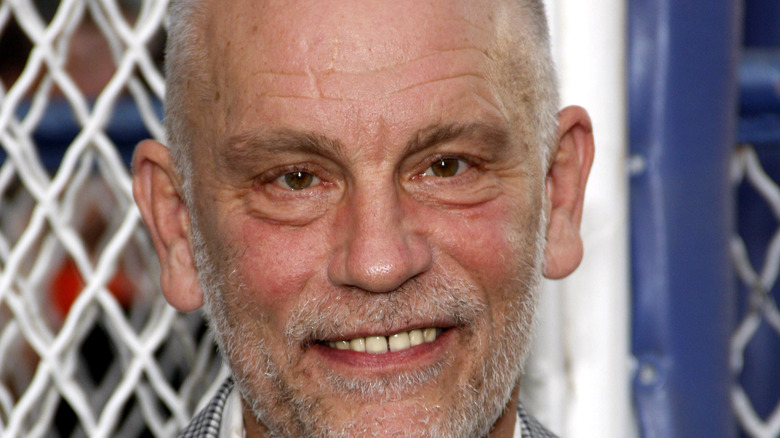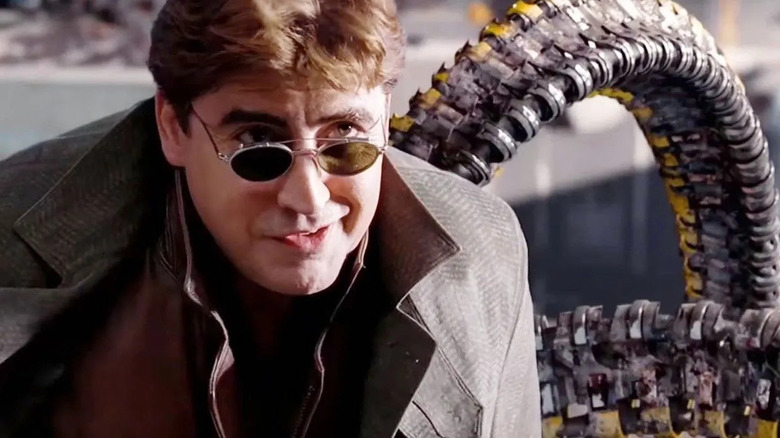The Untold Truth Of Willem Dafoe's Green Goblin
Spider-Man has one of the comic book world's most intriguing and eclectic casts of super villains, with none more deadly than the Green Goblin. Created by Stan Lee and Steve Ditko, the character was originally unleashed in the pages of "The Amazing Spider-Man" #14. Intended as a one-off villain, the character was received well enough that he became an important mainstay of the series. Along the way, the Goblin would be fleshed out, eventually being slotted into the role of Spidey's deadliest nemesis. As the catalyst for several major events in the comics, the character's legacy has long since been secured.
The Green Goblin received an added boost in popularity from his inclusion in Sam Raimi's "Spider-Man" in 2002. Willem Dafoe had the honor of bringing the glider-riding, pumpkin bomb enthusiast to the big screen, and his rendition of the character wound up being so popular that he reprised the role in "Spider-Man: No Way Home" to great acclaim. Here are some facts about Dafoe's Green Goblin that you might not already know.
Dafoe really fought for the role
It's immediately worth noting just how hard Willem Dafoe fought for the role of the Green Goblin. Bear in mind this was the early 2000s, when comic book movies were only just starting to become a hot commodity. Prior films like "Blade" and "X-Men" found success both financially and critically, which helped to change the perception of comic books as box office poison. Dafoe definitely sensed the change in the industry and, desiring a return to bigger studio films, jumped at the opportunity. "I met with Sam [Raimi] and the studio and I said, 'I want to do this,'" Dafoe told The Guardian. "And the studio said, 'Well we've got a long list of people in mind.' And I said, 'Put me on tape.'" The studio then sent a casting director to Spain, where Dafoe was filming a different movie at the time, and he wound up doing a screen test in his hotel room (per Vanity Fair).
The actor has also noted just how many of his contemporaries put their noses up in regards to his desire for the role. Dafoe's clear passion and desire for the role of the Goblin definitely resonated with the casting director and, eventually, with Sam Raimi as well. This would lead to Dafoe being cast in the role, and the rest, as they say, is history.
The original Green Goblin design was much different
Whether you love it or hate it, the Green Goblin's live-action costume is certainly striking. However, the final version of Gobby's on-screen outfit was initially going to look much different than the one we got. Early on in the film's production, the design of the Green Goblin was originally much more in line with his comic book counterpart. As opposed to the final version — a high-tech flight suit and helmet — the original look was more visually detailed (per The Hollywood Reporter). That older design has been archived via a series of behind-the-scenes videos from special effects studio Amalgamated Dynamics.
Through these archived videos, the design is revealed to have had an extremely expressive face and piercing yellow eyes. Additionally, the mask would've included the Goblin's signature large ears and a variation of his extravagant purple cap. As mechanically impressive as the old look was, it ultimately proved too complicated and cumbersome for any potential actor's use for an entire production. This would lead to the more comic-accurate design being scrapped, resulting in the (comparatively) less cumbersome final design. Still, it's interesting to think about how the movie might have been different with the original look in play.
Criticisms of the 2002 costume were reflected in No Way Home
As technically impressive as the live-action Green Goblin suit was, it sadly wasn't received the best by hardcore comic book fans. The suit and, more specifically, the Goblin's helmet was the subject of much lampooning and criticism from Spidey fans. Even renowned parodist Weird Al Yankovic would take a swing at the botched design in his 2003 song "Ode to a Superhero." Even in the 20 years since the release of the original film, jokes about the design have never wavered. Ultimately, it would be these criticisms that caused the creative team behind "Spider-Man: No Way Home" to make some major changes.
In an interview with The New York Times, Dafoe confirmed that the criticisms against the original design were kept in mind during production on "No Way Home." This would result in Norman destroying the helmet in an act of defiance after his first appearance in the film. For the remainder of the movie, Dafoe would be free to showcase his extremely expressive face as the Goblin in a more comics-accurate outfit. The ability to be the Green Goblin with his face fully exposed definitely allowed Dafoe to elevate the character's sadistic menace. For many fans and critics, it was a special treat to see the character showcased in a different and far more sinister light.
Dafoe did his own stunts
It's very clear from his interviews and performances that Willem Dafoe doesn't go halfway with any role that he's given. The man will often go above and beyond what would be expected of the average Hollywood actor. Whether it be strenuous physical demands or potential public outcry, Dafoe never seems hindered by the circumstances he's given. Examples of this include him subjecting himself to intense physical conditions for "Platoon" and the religious controversies of "The Last Temptation of Christ." But most relevant here is the desire he had to do the stunt work needed for the Green Goblin. In a 2002 interview with The Guardian, Dafoe discussed his desire to lean into the physical aspect of the character. While not being allowed to perform every stunt, Dafoe was present in the Goblin suit for a majority of the 2002 film.
The actor repeated that decision when given the call to play Green Goblin again. Apparently, one of the deciding factors for whether he would return in "No Way Home" was being allowed to do his own stunts once again. Speaking with GQ Magazine, Dafoe said, "I make a lot of budget-challenged movies. So it's nice to have all the technical stuff to work with."
Dafoe's Green Goblin had literary inspirations
Prior to his three-film "Spider-Man stint, Sam Raimi was best known for his work on the "Evil Dead" trilogy. Given that legacy in the horror genre, it shouldn't be surprising that horror elements have wormed their way into his other films. This is evident in all the mad-science-related origins of Spider-Man's foes, most notably the Green Goblin. Additionally, a celebrated literary horror classic would play a major part in the development of the live-action Goblin. In a 2019 GQ interview, Dafoe recounted being handed a copy of "The Strange Case of Dr. Jekyll and Mr. Hyde."
That literary influence would help serve as the foundation for the duality between Norman Osborn and the Green Goblin. It was definitely a wise move from Raimi, as Dafoe wound up having several scenes where Norman converses with his sinister alter ego. While certainly over the top in delivery, the scenes of Norman at odds with himself still ooze a sense of terror and dread. It's also an appropriate homage given the similar mad-science elements of the two stories. When you want your villain to exude terror, having a director who knows what sources to take cues from definitely doesn't hurt.
Green Goblin's teeth represent his duality
This one's a rather bizarre blink-and-you'll-miss-it detail, but it's one that definitely informs a lot about the Green Goblin's duality. The two sides of Willem Dafoe's Norman Osborn were heavily inspired by "The Strange Case of Dr. Jekyll and Mr. Hyde," and the tension between those different personalities manifested in a number of ways on the screen. This is perhaps best represented in the iconic sequence where Dafoe, portraying both Osborn and the Goblin, basically acts off of himself. Via a mirror and some nifty camera shots, Norman gets to have some proper face time with his newly created alter ego.
Some eagle-eyed fans have pointed out a rather curious detail regarding, of all things, Norman's teeth. When shown side-by-side, it's clear to see that the Goblin has Dafoe's natural, less "perfect" grin, whereas regular Norman's teeth are more, well, normal — all thanks to some dental prosthetics. It's an effective visual touch that allows Dafoe's performances as Norman's dueling personalities to feel even more distinct from one another.
Dafoe has deep respect for Sam Raimi as a director
Sam Raimi is a deeply passionate director and filmmaker. That passion is essential to each of his movies, especially his more eclectic genre films like "The Evil Dead." The man has never been afraid to get his hands dirty or go the extra mile to ensure that the final product is achieved, and his enthusiasm for cinema has earned him a place in the hearts of many of his performers, including Willem Dafoe. In an interview with GQ, Dafoe said that Raimi "did a miracle thing" by blending spectacle and personal storytelling in the movie. Even when talking about projects filmed long after "Spider-Man," Dafoe can't seem to help but reflect on his time in the Goblin suit.
When promoting his role in DC's "Aquaman," Dafoe cited his experience working with Raimi and discussed the director's similarities to James Wan. Talking with Collider, the actor said that "[Wan's] enthusiasm reminds me, very much, of Sam Raimi's enthusiasm." That seems like a fair comparison given the two creators' horror genre origins. In regards to "Spider-Man," Dafoe stated that "...one of the most impressive things was that it didn't feel like an industry film. It felt like a personal film." It's very clear that even more than a decade later, Dafoe still regards Raimi and his vision quite highly.
Other actors were considered for Green Goblin
It's always interesting to learn about the paths not taken, especially in regards to the casting decisions for major films. The role of the Green Goblin was a particularly competitive one, but who else was in talks to don the villain's helmet before Dafoe snagged it for himself? As it turns out, several big names were in the running to play the live-action part of Spidey's most famous adversary.
At one point, John Malkovich was considered for the role, but he told Empire Online that he turned it down over money issues and an aversion to the genre (via IGN). Another name in the running was future Ghost Rider Nicolas Cage (per EW). And last but not least, Jason Issacs, best known as Lucius Malfoy in the "Harry Potter" movies, was considered for the part. Issacs recounted his audition with Raimi in an interview with Den of Geek, stating that he thought he was "too young" at the time despite the director's interest. Though these other actors are all immensely talented and would have surely delivered interesting performances, it's impossible to imagine any other star but Dafoe in the role, especially when considering how iconic his portrayal has become.
Green Goblin was originally a co-villain
En route to its production in the early 2000s, the screenplay for the first "Spider-Man" went through many changes. That's not uncommon, as many blockbuster movies go through a tidal wave of tweaks and reconfigurations. Bear in mind that the notion of a live-action Spider-Man film had been quietly percolating for some time. The project had gone through many different homes and attached creators, with even James Cameron taking a swing at it (per Variety). After Sony took over the film in the late 1990s, the script would be reworked by the prolific David Koepp.
As discussed in "Spiderman Confidential" by Edward Gross, Koepp's first revision of the script –- while maintaining aspects of Cameron's story –- was much closer to the eventual final product. However, one major difference in his preliminary version was the addition of a second villain –- that being Otto Octavius AKA Doctor Octopus. This proposed double-dose of villainy would eventually be truncated to just the Green Goblin as the main villain. The apparent reason for the change was that Sam Raimi had a desire to showcase father-son themes between Norman Osborn and Peter Parker. Doc Ock would eventually get his time to shine in the sequel, played spectacularly by Alfred Molena. Green Goblin and Doc Ock would have to wait until "No Way Home" in 2021 to finally share any screen time with each other.
